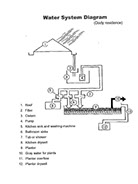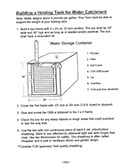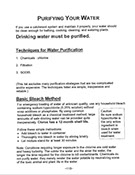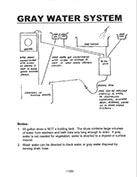Water availability will always help determine what can be achieved on the homestead. Because every homestead is different, a good water system must be customized to meet your needs. Call for consultation.

WATER SYSTEM DIAGRAM pdf
WATER CATCHMENT pdf
WATER PURIFICATION pdf
GRAY WATER SYSTEM pdf
Our water system was designed to fit into most third-world settings. It doesn’t rely on lots of expensive equipment that uses lots of energy. We wanted the system to be low-tech, low-maintenance and inexpensive. Since we've been in a very long drought cycle, we’ve had a good test for our water system. Our rainfall has averaged 9-13 inches per year. Seven or eight inches is considered a desert. Our rain usually falls during April/May or July/August. We get heavy rains, often as much as 3 inches per hour. Then we may not see rain again for several months.
Our water system uses rainwater catchment as its primary source. We chose not to put in a well because of it’s initial cost, $15k - 25k at a minimum of 400 feet, and because such a deep well would require more energy to operate than we were willing to pay for. Since many missionaries we serve live in places without wells, we wanted to experience what that meant on a day to day basis. It should be noted that we do our laundry at a laundromat.
Rainwater catchment is one of the oldest, simplest and most cost effective water strategies available. We used a rubber roof on our home which allows us to drink the water that we capture. We use a simple ceramic filter for drinking water only. We can use the water for bathing, cleaning and watering the garden without any filtration.
Our roof is about 1900 square feet. It provides about 1000 gallons for every inch of rain. Our Bunkhouse provides about 173 gallons per inch. That's what we have to work with. If we get 9 inches of rain per year, we have a total amount of approximately 10,557 gallons. To contain the water we have a cistern under our house that holds 4000 gallons. This cistern overflows into another cistern which is outside. This buried cistern is made from 350 old tires and a pond liner. See water catchment pdf. The outdoor cistern is used only for the garden. If we run out of water, we purchase water from a neighbor who has a well. In fifteen droughty years we've purchased water for the garden only, in only two of those years.
With less than 11,000 gallons of water per year, we must use every drop with great care. We have created a gray water system that allows us to use every drop of water twice. We send used water to trees, garden and landscape. Since we use a sawdust toilet, none of our water is fouled by human waste. If you want to use gray water in the garden, it must be done with great care. See gray water pdf.
To provide water for our landscape we also use techniques to direct rainwater to plants and trees. See Brad Lancaster’s great books, Rainwater Catchment for DRYLANDS and Beyond, Volumes I and II, for strategies that maximize the effectiveness of ALL the water that falls on our property.
The bottom line is this: For fifteen years we have had all the water that we have needed to operate our home and garden, getting water during thirteen of those years, only from the sky.
Water
Quantity
1 quart
½ gallon
1 gallon
5 gallons
120 gallons
Water
Condition
clear
cloudy
clear
cloudy
clear
cloudy
clear
cloudy
clear
cloudy
5.25% Sodium Hypochlorite
2 drops
4 drops
4 drops
8 drops
8 drops
16 drops
½ teaspoon
1 teaspoon
2 ounces
4 ounces
From Making the Best of Basics by James Talmage Stevens, Gold Leaf Press, ©1997.
Safety Note 2014: For the past three or four years, the manufacturers of bleach have changed the percentage of the active ingredient, sodium hypochlorite in their products. You must make sure that the sodium hypochlorite is at least 5.25%
If you are a person who learns best by doing, then Abundaculture training with Jack Dody is your kind of training. The rich experiences and resources he has brought together over three decades are priceless. He lives out what he teaches, and his training is deeply rooted in and saturated with Scripture. As a worker headed to the deserts of Chad with my family, I considered the environment in central Colorado to be similar to Chad: dry and difficult. But even if you are going to the jungle or urban-center, the practical daily living skills surrounding homesteading, making clean water, growing food, reusing waste, and producing sustainable energy will be helpful for you and can be a ministry to your neighbors. I highly recommend Abundaculture training with Jack Dody, and I promise you that there will not be a dull moment living off the grid with the Dodys!
–Justin, serving in Chad









